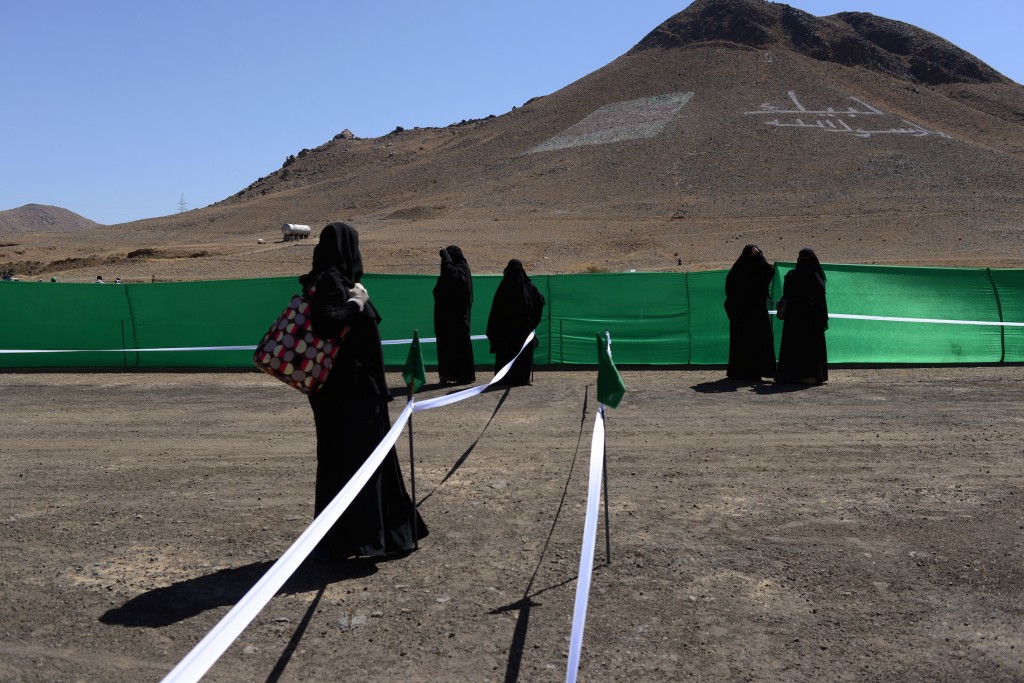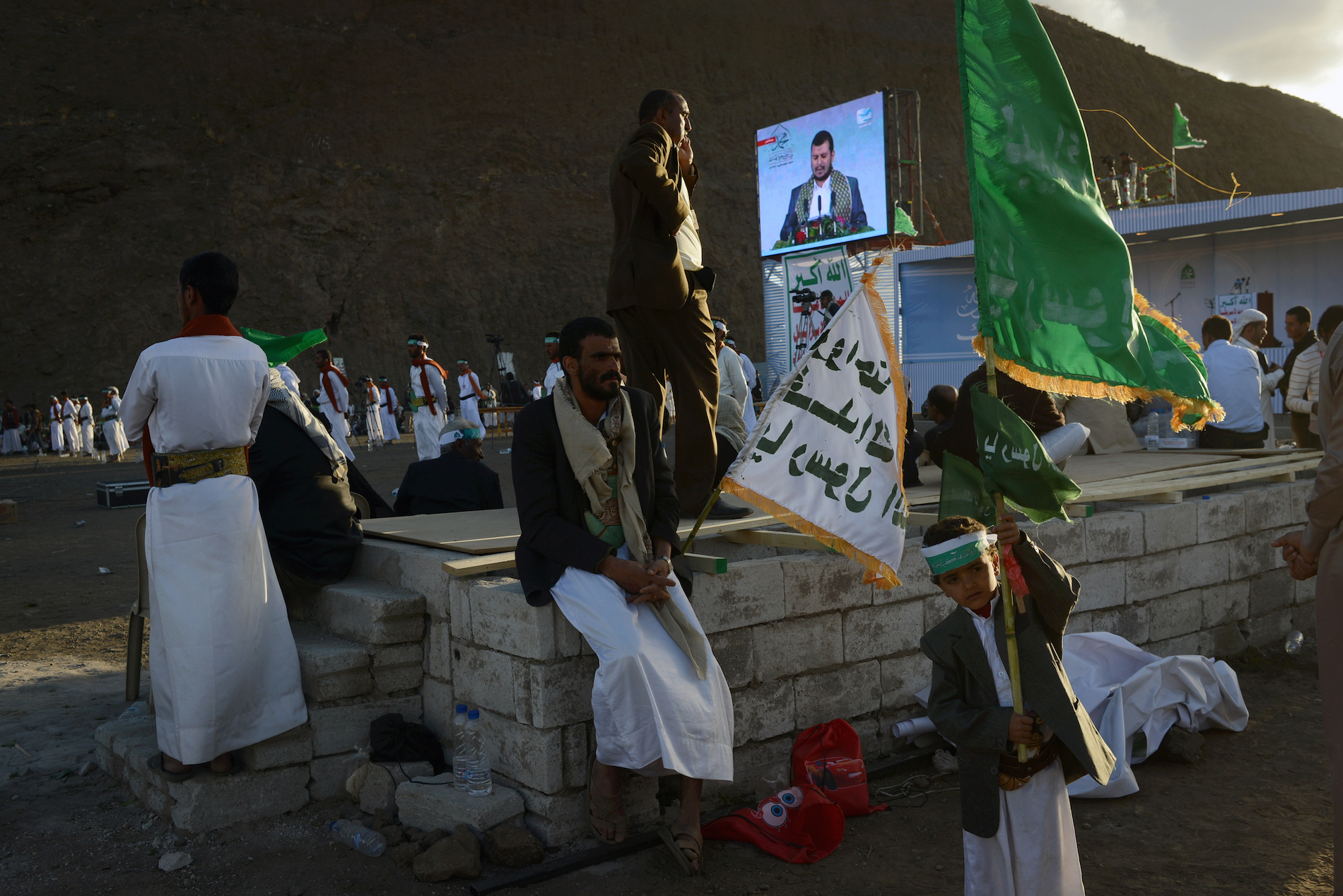Top photo: Houthi supporters gather to celebrate the Prophet Mohammad’s birthday and hear a speech from their leader, Abdul Malik Houthi. January 24, 2013, Heziez, Yemen.
The writer wishes to keep her identity undisclosed, as the story is a sensitive political topic in Yemen.
In post-revolution Yemen, most reports from major news outlets on the continuing conflict all blend together. Whether there is an Al Qaeda attack, tribal kidnapping, bombardment on the Southern Movement, or a minority sect insurgency, the writing rarely goes beyond “Yemen on the Brink” or “Rebel Militia Attacks Army Base in Yemen’s North.” The lack of coverage can be blamed partially on the Yemeni government’s lack of transparency in reports regarding conflict, blockage of international journalists from entering the country, and deporting of the few who remain. Yet outlets have the responsibility to examine both sides of all conflicts, rather than only looking to Yemeni government sources and websites affiliated with one party or sect. This imbalance in reporting is glaringly obvious in reports surrounding the most recent (and ongoing) conflict in Yemen.
The Houthis are a revivalist religious and social movement in Yemen, started by a small group of Zaydi Shia – a sect unique to Yemen – for political representation and an end to government persecution. Vehemently opposed to the policies of Islah (Yemen’s wing of the Muslim Brotherhood), Al Qaeda, and the Yemeni government for its complicity with American and Israeli political tactics, the Houthis have a violent slogan that takes many Westerners by surprise, “Death to America, Death to Israel, Damn the Jews, Victory to Islam.” Yet unlike Al Qaeda or other terrorist groups, the Houthis have not once attacked Western interests, nor have they expressed the desire to expand their movement outside Yemen. In fact, leadership and followers are routinely welcoming to Americans as individuals – it is the governments and policies of said countries they despise.
Since their humble beginnings as a lobby for Zaydi identity in the early 1990s, the Houthis have been beaten down by the Yemeni government in six wars from 2004-2010, participated in the Yemeni Revolution, and risen from that revolution as one of the fastest-growing and most influential groups in the country. The founder and original leader, Hussein al Houthi, was killed in the first war against the Yemeni government in 2004. Since then, his brother Abdul Malik has taken over the movement.

The mass media’s reference to the organization as the “Houthi rebel group,” or as a political movement with an armed wing, is inaccurate and shallow. To imply one is a rebel group would suggest they hope to take over the government. Yemeni authorities do indeed believe and suggest exactly that, but aims of the Houthis are more complex. While they call for the downfall of the regime, they also call for free and fair elections as the last one was a one-man choice arranged by the Gulf Cooperation Council – and backed by the United States. It is true that the Houthis have organized a portion of their supporters into a group that fights, with better leadership and tactics than any loosely affiliated group in Yemen. But nearly every male in Yemen is armed, particularly in rural areas where tribal hierarchy and laws are prevalent in the absence of the state: this absence being the very reason that tribes (which, in Yemen, are geographic and familial loyalty groups, rather than an ethically unique group) were created. Every tribe in Yemen has a leader, for whom the members will fight and follow, just like the Houthis. The key difference is that the Houthis are a conglomeration of allied tribes, whose leaders fall in with the Houthis’ political ideals.
Yet the true motives of the Houthis are ambiguous: their leadership has been attacked and assassinated, but the most recent conflict highlights how quickly intentions can fall apart. While Houthi leadership has been targeted, they often pride themselves in fighting fairly and equally—and the most recent battle put this claim to the test.
The latest headlines in Yemen revolve around a conflict amongst Houthi supporters, government troops, and rival tribes over Amran, a harsh and dusty province just north of the capital, Sana’a. While battles in Yemen generally stick to rural areas to protect families, the Houthis fought it out with the 310th Brigade headed by Hamid Kushaibi – a general reportedly close to the Sunni and Muslim Brotherhood-affiliated Islah. In the end, Houthi fighters captured and executed Kushaibi. Houthi fighters also reportedly looted government offices and stole a large amount of military equipment from the town. Each side – the government and Houthi leadership – claim they were attacked first, and Houthi leadership dismisses the claims of looting. In this case, either side could be telling the truth, as both stand to gain from control of Amran: the government would keep its political and military right of sovereignty over the provinces; the Houthis would gain strategic control over an area that is already ideologically theirs. Since the end of the Yemeni Revolution in 2012, support for the Houthis has spread from their stronghold in the northern province of Saada and pockets of the capital to many governors of northern Yemen.
The result of the conflict is per normal in Yemen: thousands have fled to the nearest large city (Sana’a, in this case), the government has condemned the Houthi actions, and the UN has called for all parties to lay down arms. This is a warning no one will likely heed.
The Houthi conflict, both past and present, has religious, tribal, and political sides to it, so it’s no wonder most news outlets have trouble wading through the muddled facts. Digging deeper to understand the ideological beginnings behind the growing power of the Houthis in Yemen is vital to understanding the story behind the headlines.




